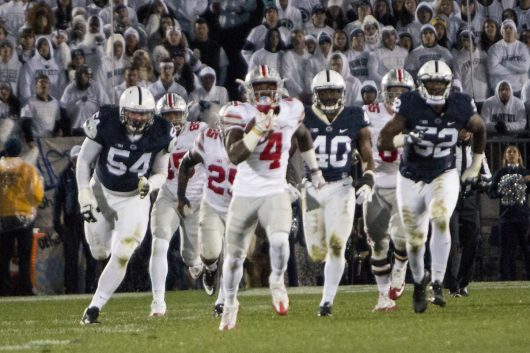
OSU junior H-back Curtis Samuel (4) runs for a touchdown during the second half of the Buckeyes game against Penn State on Oct. 22. The Buckeyes lost 24-21. Credit: Alexa Mavrogianis | Photo Editor
STATE COLLEGE, Pa. — The goal for any offense is to get the ball into the hands of its playmakers. It’s to give the ball to those athletes in space with the hope of creating a long gain. For the No. 2 Ohio State Buckeyes, at some times that can be challenging due to the amount of raw talent on the field. But through the team’s first six games, junior H-back Curtis Samuel asserted himself as the most dynamic player on the sideline.
When looking back on its loss against Penn State on Saturday, OSU might want to consider using Samuel more.
In the first quarter, Samuel registered zero touches and the Buckeyes scored zero points in a quarter for the first time all season. However, the inefficiency of the offense wasn’t an anomaly, and the stagnation begins with not getting the ball in Samuel’s hands.
OSU had accumulated just 61 yards of offense after the first quarter, not one of those belonging to Samuel. It took redshirt junior quarterback J.T. Barrett until the under-10 minute mark of the second quarter to get the ball to Samuel, which resulted in a first down and 15-yard gain. His next catch, too, moved the sticks.
On that drive, Barrett threw a touchdown pass to redshirt junior tight end Marcus Baugh, putting the Buckeyes up 9-0.
Samuel began to be more involved in the beginning of the second half. It was almost as if OSU coach Urban Meyer remembered how important Samuel is to the offense. The Brooklyn native took his first carry of the night for 74 yards for a touchdown, taking the wind out of Penn State’s sails.
Then, all of a sudden, Samuel wasn’t anywhere to be found in the run game. He had just one carry after the touchdown run and he was held to 10 total touches for the game with 139 total yards of offense. The Buckeyes stagnant offense allowed Penn State to get back into the game, with some help from OSU’s special teams, and ultimately ended in a 24-21 loss — the first of OSU’s season.
Meyer simply said after the game that Samuel is much too important to the success of the offense to have just 10 touches and two carries.
“We got to get him more than that,” he said.
The two games where OSU’s offensive inconsistencies were the most prevalent were Indiana and Penn State. Against the Hoosiers, Samuel did not have a touch in the first quarter and did not record a reception. Against Penn State, Samuel surpassed his average of 5.3 receptions per game, but only had two carries, which is seven attempts lower than his season average.
Play calling is one factor in an offense that is having difficulty with moving the ball, and execution is another. Redshirt freshman running back Mike Weber and senior H-back Dontre Wilson are two other dual-threat players who are used in the passing and running game, but the offense doesn’t have an urgency to get one guy the ball over the other.
“It’s not like, ‘hey, Curtis has got to touch the ball, Dontre has got to touch the ball, Mike Weber has got to touch the ball.’ We’re not doing that,” Barrett said. “I’m going to tell you that from here on out, there’s not going to be any, ‘hey, let’s get Curtis the ball on this play.’ It’s not going to be like that.”
In 2015, OSU had an embarrassment of riches concerning the talent at skill positions. That team struggled in finding the right amount of touches for each player on the offense. This season, in many ways OSU is still finding a balance in its offense. However, it is coming at the expense of neglecting Samuel.
Although Meyer said he needs to get the ball to Samuel more, Barrett said that the offense doesn’t function best when one player is singled out to get the ball.
“We’re going to run our plays and if Curtis happens to get the ball, then Curtis happens to get the ball,” Barrett said. “Our offense runs very well when that happens. We’re not going to start going backwards into ‘this person has to get the ball, that person has to get the ball’ because then you’re just predictable. That’s not how we play. That’s not good football.”


